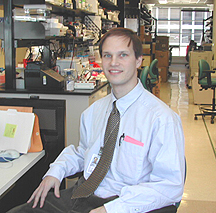
| T H E N I H C A T A L Y S T | J A N U A R Y – F E B R U A R Y 2003 |
|
|
|
VRC Launches Clinical TrialsMODIFIED VACCINIA TARGETED AS POTENTIAL SMALLPOX VACCINE |
text and photo by Fran Pollner |
 |
|
Lewis
McCurdy
|
A clinical trial begun in the waning days of 2002 may yield results by late summer that will offer up a safer smallpox vaccine than the currently available Dryvax formulation.
In late December, as the Bush administration launched its smallpox vaccine plan with mandatory inoculation of military personnel, the Vaccine Research Center launched its first human trial to determine whether modified vaccinia Ankara (MVA) can confer equal protection against smallpox without the adverse effects that have made Dryvax so controversial.
Results will not be forthcoming in time to alter vaccine choice for the military and the first waves of health-care workers scheduled for smallpox vaccination under the Bush plan. But much more will be known about the safety and immunogenicity of MVA by the time of voluntary vaccination of the general public—currently scheduled to begin in 2004, Lewis McCurdy, principal investigator in the VRC trial, noted in an interview with the Catalyst during the first week of enrollment.
The trial involves vaccine-naïve persons between 18 and 30 years old; the VRC is also planning to launch another study early this year that will test MVA in people age 31 to 60 with a history of vaccinia vaccination. Assuming successful outcomes, it’s anticipated that other studies—not necessarily in the VRC—will be done to determine safety and immunogenicity in more vulnerable populations, such as the elderly, children and infants, and people with skin conditions and other immunocompromised patients for whom Dryvax is contraindicated, McCurdy said.
MVA was originally envisioned by Barney Graham, chief of the VRC Clinical Trials Core, as a potential substitute for Dryvax in the routine vaccination of lab personnel working with vaccinia. The idea to test MVA as a potential new vaccine for smallpox arose with the "threat of bioterrorism after September 11," McCurdy recounted.
Safety First
There’s ample reason to believe that MVA’s safety will be established in this phase 1/phase 2 trial, McCurdy said. Whereas Dryvax is a vaccinia strain capable of replicating at the lesion site, MVA is an attenuated strain that has been passaged more than 500 times and is unable to replicate in mammalian cells, he noted. He cited clinical studies conducted in Germany in the 1970s demonstrating that the modified strain protected against Dryvax complications and was well tolerated by all recipients, including the elderly and children. Studies of high-dose MVA in immunocompromised macaques, undertaken by NIAID’s Bernie Moss and Linda Wyatt in collaboration with Dutch investigators (K.J. Stittelaar, T. Kuiken, R.L. de Swart, et al. Vaccine 19:3700–3709, 2001) established MVA’s safety in a vulnerable nonhuman primate population. MVA, he observed, is being considered as an HIV vaccine vector.
"MVA should be safe in almost all populations," McCurdy said, "but it’s never been field tested against smallpox, and no one knows if it’s going to be effective."
Correlates of Immunity
"No one really knows what the correlates of immunity are," McCurdy continued. "After Edward Jenner demonstrated protection using a poxvirus in the late 1700s, people simply continued to use it without understanding why it worked. It’s now presumed that the development of neutralizing antibodies is important for protection against smallpox, but this has not been demonstrated specifically."
Because MVA does not cause a visible reaction, or a "take," at the injection site, that cannot be used as a sign of immunity. The VRC investigators will instead be looking for neutralizing antibodies and assessing T-cell function via intracellular cytokine staining for interferon-g and TNF-a.
To determine whether neutralizing antibodies against vaccinia correlate with neutralizing antibodies against variola (smallpox), which also has never been shown, selected samples will be sent to the Centers for Disease Control and Prevention (CDC), which has the requisite BSL4 laboratory for the study. That work will be done by Inger Damon, who heads the CDC poxvirus section, in collaboration with Graham. The VRC team is also conducting mouse studies to get correlative data on poxvirus protection, which will supplement its clinical findings in the process of pursuing a license for a new vaccine.
"Our hope is that MVA alone will elicit immunity similar to that with Dryvax. If it turns out that MVA alone is not as immunogenic as we think it will be, then it might be worth considering using it several weeks to a month before giving Dryvax to minimize Dryvax complications," McCurdy commented.
The VRC is recruiting 105 people for the study with a vaccine-naïve population. At the time of the Catalyst interview, the team had gotten about 60 calls from potential volunteers, most at NIH; 15 people had been screened, and 14 of these qualified for entry. The trial is seeking accrual as quickly as possible, with plans to vaccinate 10 to 20 people weekly. The randomized, blinded trial will pit placebo against each of three MVA regimens: one dose (1 x 108 pfu); two doses, separated by one month; or three doses at 0, 1, and 3 months. In addition, there will be another cohort in the first group who will receive Dryvax instead of MVA. Three months after their last injection, all volunteers will get a Dryvax challenge. More information on the trial can be found here.
The trial of previously
immunized individuals between ages 31 and 60 will get underway in February.
To be eligible, candidates must have received their last vaccinia shot at least
10 years ago and have a demonstrable scar. The format will be similar to the
first trial, with cohorts receiving either one or two MVA doses followed by
a Dryvax challenge. Most of the 80 volunteers needed are expected to come from
NIH. For more information, call Tiffany
Alley at the VRC, 301-594-8569, or call 1-866-833-LIFE.
![]()